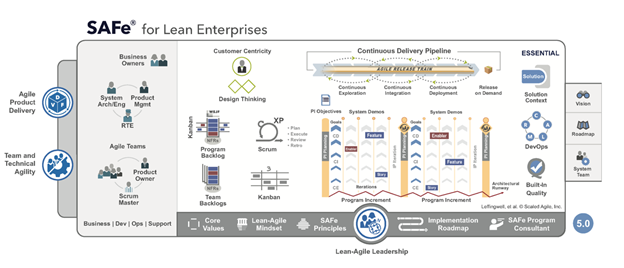Preparing for Your Virtual SAFe PI Planning Event
“Those who master large-scale software delivery will define the economic landscape of the 21st century.” Mik Kersten, author of Project to Product
Scaled Agile Framework® (SAFe®) is a leading framework for scaling Agile across the enterprise. SAFe is designed to help businesses continuously and more efficiently deliver value on a regular and predictable schedule. It provides a knowledge base of proven, integrated principles and practices to support enterprise agility.
While SAFe is normally associated with Large Group Planning events (SAFe Program Increment (PI) Planning 2-day sessions), many organizations have had years of success using SAFe for teams in distributed and/or virtual environments.
This blog series is divided into three Sections, 1) Preparing for your Virtual SAFe PI Planning event, 2) Conducting your Virtual SAFe PI Planning Event, and 3) Conducting your Virtual Program Increment.
“Fail to Plan… Plan to Fail” – Benjamin Franklin. We recommend you start your SAFe Program Implement planning two to six weeks out. The more time the better, as it allows you to build, socialize, and secure buy-in and approvals for your upcoming PI.

Scaled Agile Framework Version 5.0 – Essential SAFe
Now, more than ever, we must be crisp, clear, and positive in our intent and messaging. We must ensure we understand and have planned for how our teams will be successful in today’s virtual world. We must ensure our goals and objectives are clear and easily understood by all. Below are some tips and best practices on preparing for your Virtual SAFe PI Planning Event.
SAFe Pre-PI Planning Leadership Team
Pull together your PI Leadership team (Product Owner, RTE, and System Arch/Eng), along with your key Stakeholders / Business Owners to plan and complete the following items and answer the big question, "what is the goal of the pi planning event?"
When Is a SAFe Pre-PI Planning Event Needed?
Coming unprepared to PI Planning is never a good idea—even worse if it’s a remote one—but running the PI Planning with most of the plan complete destroys the purpose and the value of this key ceremony. So, how much pre-planning is enough? The answer to that is “it depends.” Every project is different, and the complexity and size of each one is a key factor to determine the right amount of pre-planning, but we offer some important tips on successful PI Planning.
“In preparing for battle I have always found that plans are useless, but planning is indispensable.” – Dwight D. Eisenhower
Defining Roles and Responsibilities SAFe Pre PI Planning
There are several tasks that should be completed prior to the SAFe PI Planning. Some are teams’ responsibilities; others are Train’s responsibilities and require cross-team collaboration. Identifying tasks, roles, and responsibilities is helpful and provides visibility during Program Implement planning. It also lets people know what is expected of them, so that they can collaborate and complete the job on time. The idea is not to place blame when something goes wrong, but to standardize processes and track progress throughout.
Engaging Presentations and Shared Facilitation
SAFe PI Planning is a long and intense event—two or more days to create the SAFe program board, draft sprints, write PI objectives, identify dependencies, and create the general plan for the next PI. Keeping people focused and engaged can be challenging. Having a crisp agenda with short time boxes can help immensely with this. The key to keeping people engaged is to ensure the information shared with them is critical to their work. Anyone will lose interest in a presentation that is not relevant to them. It is also important to remember to be Agile about the process - inspect and adapt and continue to refine both the input to and the output from your planning events.
The importance of the facilitation dynamic during remote PI planning cannot be understated. Remote planning cannot provide all the same benefits as meeting in person. To resolve some of the disengagement of being remote, try spreading the ceremonies’ facilitation among the Release Train Engineer and Scrum Masters. The retrospective, program risks, ROAM activity, and confidence vote may need to be run by different people. In this scenario, each team has the opportunity to be the center of attention, making them feel more involved and accountable for the whole ceremony.
Vision and Mission of SAFe for Teams
Ensure your Vision and Mission are clear and understood by all. We recommend no more than two slides to effectively communicate these to your SAFe Agile Release Train (ART) team members. In our current fully virtual world, there are way too many distractions. Way too many ways to lose focus. Keep your message and communication crisp and lean.
Product Roadmap
How does our current work fit into our overall plan? What Business Functionality do you want to deliver quarter over quarter? Great Product Roadmaps are 1-slide diagrams that communicate the “Why” and business functionality we would like to deliver for our customers. They usually span multiple quarters to years and serve as a high-level, visual summary of the product’s strategic objectives and expectations. These present your strategic vision and goals to both your ART and Supplier teams.
Great SAFe Product Roadmaps are also your prioritized Feature backlog that your ART refers to throughout the initiative to ensure they are continuously delivering the highest value.
Release Plan
Great Release Plans translate your Product Roadmap’s high-level strategy and goals into an actionable plan with specific Business and Technology Epics and Features you want to complete across the product timeline. Great Release Plans are very detailed and specific for the current PI and become less so for future PIs. They are refined and locked in the weeks leading up to your next PI. Your Release Plan seeks to easily and efficiently show the features and enhancements targeted for your upcoming PI.
With your Vision, Mission, PI Leadership team, your top 7 to 10 Features (Business and Technology), and your PI Planning Event scheduled out, you are ready to conduct your 1st Virtual PI. Outputs will include the Team and Program PI Objectives, the SAFe Program Board, team and program risks, and Team commitment to the plan.
Looking for more information on SAFe? Check out our two-part blog series, "Scaling Great Heights with SAFe," and view our Agile Consulting Services.

